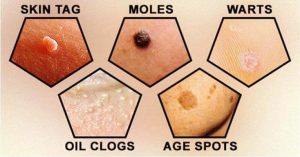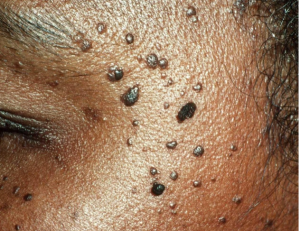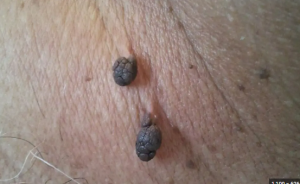Moles and skin tags are unusual growths that develop on the body. While they might look similar sometimes, they both have their distinctions and can sometimes carry different levels of health risks.
Most times we see these strange growths on our bodies and wonder why they are there. And even though they are mostly benign and cause no discomfort, they can sometimes be positioned in a prominent place on the body, compromising its aesthetic integrity.
Moles

Moles or nevi are regular body lesions that are caused when the cells responsible for skin pigmentation [melanocytes] cluster together instead of spreading out on the skin.
According to the online health portal WebMD, moles can either be brown or dark in color and they can be positioned in any place on the body, singularly or in clusters. While moles can sometimes be acquired from birth [congenital], they can also form while we grow or develop.
Causes and risk factors of moles

Just as we’ve earlier established, moles are formed when skin cells responsible for pigmentation are concentrated on a spot or an area, instead of spreading out on the entire skin, leaving a much darker shade behind. This shade could be dark, brown, or even pink.
Even though the actual cause of moles forming has not been established and researches are still ongoing, some health authorities believe that genetics goes a long way in determining who gets it.
Reputable online portals like Mayo Clinic and Healthline also state that exposing the skin to the sun or ultra violet rays also increases the chances of moles forming on the skin.
Physicians warn that some moles carry a very high melanoma risk and should be checked out by a dermatologist.
Skin tags

Skin tags are small wart-like growths that form on the skin. One easy way to distinguish them is the fact that they are connected to the skin by a thinner layer of skin, looking like they grew out from them.
Causes and risk factors of skin tags
As people age, the chances of getting skin tags increase, and it gets higher with overweight individuals.
According to the online health portal Everydayhealth, skin tags are more common with pregnancy and weight gain. The article goes on further to explain that even though the actual cause of skin tag is unknown, it possibly might be an effect of skin rubbing together, a common downside of obesity.
New Jersey-based dermatologist, Dr. Rebecca Baxt, says skin tags can be found more among people dealing with diabetes; and that coming from a lineage of people with skin tags also increases one’s risk of having them
Skin tags are usually painless; however, if you feel pain or any form of discomfort from one, have it checked by a dermatologist, as skin tags can be a symptom of a complex genetic disorder that makes one highly susceptible to basal cell carcinoma, a skin cancer type.
Remedies
Unwanted and cancerous moles can be removed by a dermatologist through a process called a surgical or shave excision; while skin tags can be removed through electrocautery — that is, using an electric current to burn it up, among others.
Very important…
Seek the help of a dermatologist in getting rid of moles or skin tags to avoid complications like profuse bleeding and likely infection.


